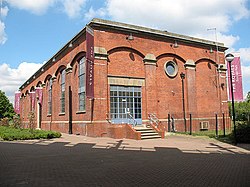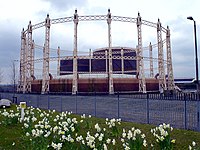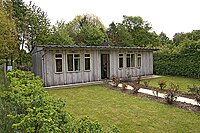Beckton
| Beckton | |
| Essex | |
|---|---|
 Old Compressor House | |
| Location | |
| Grid reference: | TQ435815 |
| Location: | 51°30’53"N, -0°4’2"E |
| Data | |
| Post town: | London |
| Postcode: | E6 |
| Dialling code: | 020 |
| Local Government | |
| Council: | Newham |
| Parliamentary constituency: |
East Ham |
Beckton is an urban neighbourhood in Essex, by the shore of the River Thames and within the industrialised belt of the metropolitan conurbation in this part of the county.
Beckton was unpopulated marshland adjacent to the Thames until the development of major industrial infrastructure to support the growing metropolis of London. The new village was built in the 19th century. Housing was created in Beckton for workers of the gas and sewage works. Between 1981 and 1995 it was within the London Docklands Development Corporation area which caused the population to increase as new homes were built and the Docklands Light Railway was constructed.
Name
Beckton is not an ancient Essex village name - the new marshland settlement was named after Simon Adams Beck, the governor of the Gas Light and Coke Company when work building Beckton Gas Works began in November 1868.
Geography
The boundaries of Beckton are essentially the A13 trunk road to the north, Barking Creek to the east, the Royal Docks to the south, and Prince Regent Lane to the west.
The area around Prince Regent Lane is also known as Custom House. Modern Beckton is divided into East Beckton, Mid Beckton, North Beckton, West Beckton, South Beckton and Cyprus. ‘Cyprus’ was named after the British acquisition of Cyprus from the Ottoman Empire in 1878, which occurred as the original estate was being built.
Beckton is at the western end of the London Riverside redevelopment zone of the Thames Gateway. Transport for London are planning a new bridge, the Thames Gateway Bridge, which will connect Beckton to Thamesmead on the southern bank of the River Thames.
History
Sewage works
Sewage treatment works were first established in 1864 as part of Joseph Bazalgette's scheme to remove sewage (and hence reduce disease) from London by creating two huge sewer pipes from the capital, one on each side of the Thames and known as the Southern and Northern Outfall Sewers. The Beckton sewage works, at the end of the northern outfall, is the fourth largest in the world and Europe's largest. It is now managed by Thames Water.
The outfall sewer has been landscaped and now also serves as the Greenway cycle track through southwest Essex. Originally sewage was pumped untreated into the Thames, and this contributed to the high death toll in the 1878 ‘’Princess Alice’’ disaster, when over 600 passengers died in Britain's worst inshore shipping tragedy.
The site was mooted in 2005 as the location for a desalination plant, but the proposal was rejected by Mayor Ken Livingstone as environmentally unacceptable. The scheme has been resurrected by the new mayor, Boris Johnson, as part of a deal with Thames Water to reduce delays in fixing roadworks throughout London.
Gasworks

Situated north and east of the Royal Docks, the area was formerly heavily industrialised, and was the location of Beckton Gas Works, the largest gasworks in Europe, which served the capital. An adjacent by-products works also produced a wide variety of products including ink, dyes, mothballs, and fertilisers, all by-products of the process of turning coal to coke in the production of town gas. When the British gas supply switched from town gas to North Sea natural gas in 1969, the gasworks closed.
An extensive toxic spoil-heap from the Gasworks was known ironically as 'Beckton Alps'. Originally running from the Northern outfall sewer south to Winsor Terrace, this was landscaped in the 1980s. Part became an 82-foot high artificial ski slope for a time, opened by Diana, Princess of Wales, with a viewing platform at the summit and a Swiss-style bar at the foot. However, the site is now derelict.
Urban development

Immediately after the Second World War, large numbers of prefabs were built in Beckton, to house those made homeless by the war. The prefab-lined streets were all named after well-known generals and war heroes, but in the redevelopment of North Beckton in the 1980s, these were all swept away with the exception of Eisenhower Drive.
Containerisation during the 1960s, and the development of the docks at Tilbury, released all the land from the Thames up to the A13 which had been earmarked for a new, North Albert Dock. The original District Plan envisaged a large Council-owned estate, and major infrastructure works—including a huge drainage scheme with pumping stations—were put in place. However, following the creation of the London Docklands Development Corporation, much of the land was sold off resulting in today's blend of largely private housing.
In more recent times, industry has left the area, leaving huge areas of brownfield land, and Beckton has been redeveloped as part of the Docklands project. It now comprises mainly housing and several out-of-town shopping centres, and the architecture is mostly post-1982. Small areas of Victorian housing survive in Winsor Terrace, originally built as accommodation for Gas Light and Coke Company staff, and in the 'Nottingham' estate off Prince Regent Lane.
The Victorian 'Cyprus' estate was rebuilt in the 1980s, but the original Cyprus public house survives (named The Ferndale, although now boarded-up, and earmarked for redevelopment, March 2008).
Gallions Reach was developed from the early 21st century, as Beckton spread south and further east, to be an essential part of the ‘Thames Gateway’ concept. "Gallions Hotel", part of the Furlong City development by the lock that links the Royal Docks to the Thames, was formerly a rail terminus which connected with passenger ships leaving for all parts of the British Empire. Many colonial officials and their families spent their last night in Britain in the Gallions Hotel, which was mentioned by Rudyard Kipling in his novel, The Light That Failed.
Transport links
There are a number of stations serving Beckton. The nearest Docklands Light Railway stations are:
- Beckton for Mid and North Beckton;
- Cyprus for the Cyprus area;
- Beckton Park for South Beckton and
- Royal Albert for West Beckton.
Beckton is near the London City Airport.
Beckton on film
Full Metal Jacket The 1987, directed by Stanley Kubrick: Gasworks were still standing derelict derelict in the early 1980s, when team came scouting for an area that could double for the battle scenes in his film,. The Gasworks rough concrete structures were painted with Vietnamese script, and then strategically dynamited so as to resemble war-torn Hue. Retail parks now cover most of the Gasworks site.
Other notable films with scenes filmed in and around the Beckton area during the 1980s include:
- For Your Eyes Only (1981 James Bond film), which featured extensive aerial views of the Gasworks in the pre-credit sequence.
- 1984, Michael Radford's 1984 film adaptation of Orwell's book: the Gasworks served as the setting for the "Proletarian Zones".
- The Cement Garden, (Andrew Birkin's 1990 film of Ian McEwan's novel), largely filmed in Beckton. Winsor House, which served as the backdrop to the film, was later demolished and the Winsor Lodge Hotel stands there now.
- Hot Fuzz (2007); in the opening minutes the Tate & Lyle factory, Silvertown, and the City Airport aprons can be seen through the window blinds of Building 1000.
The video for Loop's 1990 single 'Arc-lite' was filmed on the set of Full Metal Jacket,[1] as was the video for the 1997 Oasis single, "D'You Know What I Mean?"
Pictures
-
Henry Addlington Close in Beckton
-
Gallions Hotel
-
Stonechat Square Mid-Beckton
-
Beckton Alps and Gasworks 1973, from the A13



